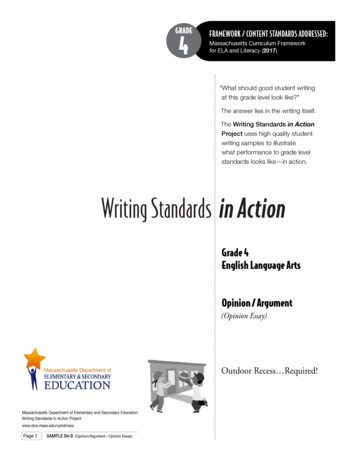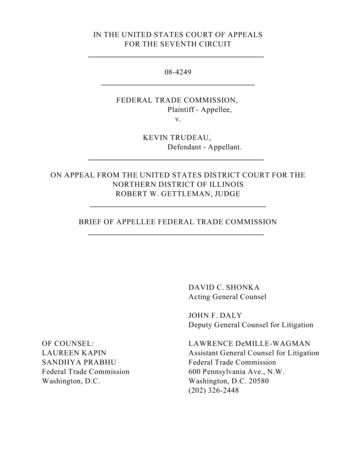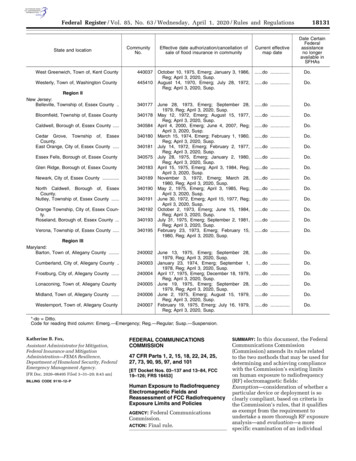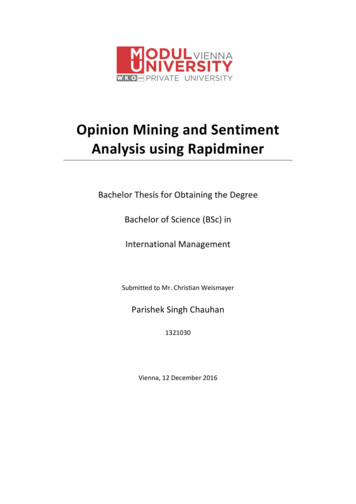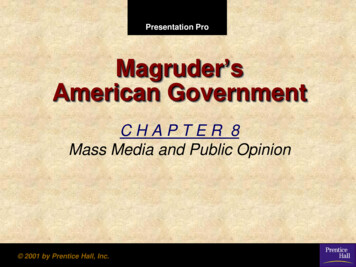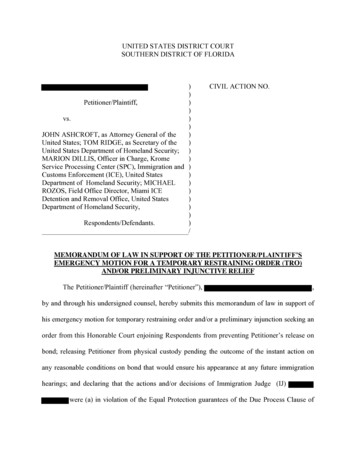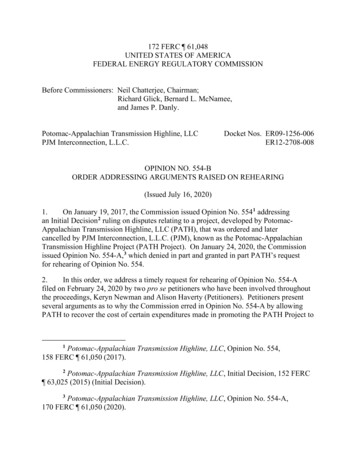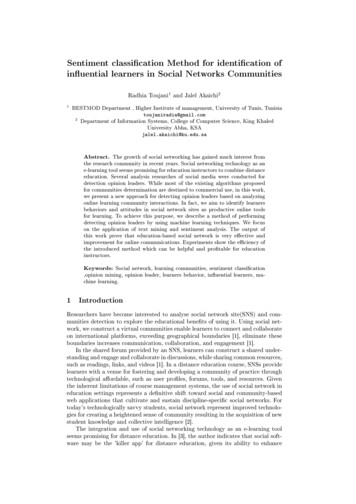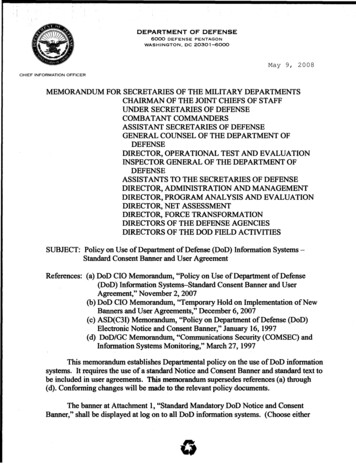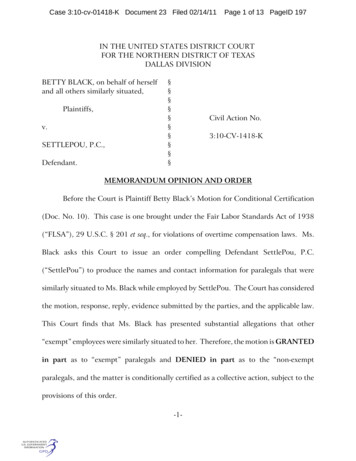
Transcription
Case 3:10-cv-01418-K Document 23 Filed 02/14/11Page 1 of 13 PageID 197IN THE UNITED STATES DISTRICT COURTFOR THE NORTHERN DISTRICT OF TEXASDALLAS DIVISIONBETTY BLACK, on behalf of herselfand all others similarly situated,Plaintiffs,v.SETTLEPOU, P.C.,Defendant.§§§§§§§§§§Civil Action No.3:10-CV-1418-KMEMORANDUM OPINION AND ORDERBefore the Court is Plaintiff Betty Black’s Motion for Conditional Certification(Doc. No. 10). This case is one brought under the Fair Labor Standards Act of 1938(“FLSA”), 29 U.S.C. § 201 et seq., for violations of overtime compensation laws. Ms.Black asks this Court to issue an order compelling Defendant SettlePou, P.C.(“SettlePou”) to produce the names and contact information for paralegals that weresimilarly situated to Ms. Black while employed by SettlePou. The Court has consideredthe motion, response, reply, evidence submitted by the parties, and the applicable law.This Court finds that Ms. Black has presented substantial allegations that other“exempt” employees were similarly situated to her. Therefore, the motion is GRANTEDin part as to “exempt” paralegals and DENIED in part as to the “non-exemptparalegals, and the matter is conditionally certified as a collective action, subject to theprovisions of this order.-1-
Case 3:10-cv-01418-K Document 23 Filed 02/14/11I.Page 2 of 13 PageID 198BackgroundPlaintiff Betty Black was employed as a paralegal by Defendant SettlePou, P.C.(“SettlePou”) from October 2005 until April 27, 2010. SettlePou is a law firm thathandles transactional, litigation, and regulatory cases. The firm, based in Dallas, Texas,currently employs thirty-six attorneys and eleven paralegals across six divisions: (1)Commercial Lending; (2) Commercial Litigation; (3) Creditor’s Rights; (4) InsuranceDefense; (5) Real Estate Transactions; and (6) Business Counseling Services.As a paralegal in the Commercial Lending division, Ms. Black alleges that herprimary responsibilities were speaking with clients, composing documents, andorganizing files. She maintains that, as a paralegal, she had no input on managementdecisions, no supervisory authority over any other employee, and required no specialtraining or certifications for her position.The FLSA requires employers to pay certain employees 150% of their normalhourly wage for each hour the employee works in excess of forty hours per workweek.“Exempt employees,” ones that do not qualify for overtime compensation, are mostcommonly executive, administrative, or professional employees, though others are listedwithin the FLSA. SettlePou asserts that it classifies its paralegal employees as “exempt”or “non-exempt,” for FLSA purposes, on a case-by-case basis according to their duties.This means that some paralegals employed by SettlePou were classified as “non-exempt”and received overtime compensation while others were classified as “exempt” and-2-
Case 3:10-cv-01418-K Document 23 Filed 02/14/11Page 3 of 13 PageID 199received none.The entire time Ms. Black was employed by SettlePou, she was classified as“exempt,”paid on a salary basis, and did not receive overtime compensation. She assertsthat her duties required her to work more than forty hours per week on a consistentbasis, coming in early, working through lunch, and leaving late and that her duties didnot qualify her for “exempt” status. Ms. Black also asserts that there were otherparalegals employed by SettlePou that were working under the same conditions.Ms. Black filed suit on July 19, 2010 for violations of FLSA requirementsregarding overtime compensation. In this motion, filed November 22, 2010, she seeksconditional certification pursuant to the collective action provisions of the FLSA. 29U.S.C. § 216(b). SettlePou opposes conditional certification and asserts that: (1) Ms.Black has not provided sufficient evidence to justify conditional certification; (2) she hasfailed to identify potential class members; and (3) any potential class members identifiedwould not be similarly situated in their job requirements and pay provisions.II.Legal StandardThe FLSA requires covered employers to pay non-exempt employees at least 150%of the employees’ normal hourly pay for each hour the employee works in excess of fortyhours per workweek.29 U.S.C. § 207(a) (2010).It also provides a remedy toemployees when employers violate the requirements of Section 207(a). 29 U.S.C. §216(b) (2010). This remedy allows a plaintiff to bring suit on her own behalf or for-3-
Case 3:10-cv-01418-K Document 23 Filed 02/14/11Page 4 of 13 PageID 200herself and on behalf of others “similarly situated.” Id.; see also Donovan v. Univ. of Tex.at El Paso, 643 F.2d 1201, 1204 (1981). Any employee wishing to join such a lawsuitmust file a consent with the court. 29 U.S.C. §216(b) (2010).A.What is “similarly situated”?There are two schools of thought on how to determine if plaintiffs are “similarlysituated” within the meaning of Section 216(b). Mooney v. Aramco Servs. Co., 54 F.3d1207, 1213–15 (5th Cir. 1995), overruled on other grounds by Desert Palace v. Costa, 539U.S. 90 (2003). Both draw their names from federal district court cases: Lusardi v. XeroxCorp., 118 F.R.D. 351, 359 (D.N.J. 1987), and Shushan v. Univ. of Colo., 132 F.R.D. 263(D. Colo. 1990). The Lusardi approach is a two-step process: (1) the “notice stage”consists of examining pleadings and any evidence advanced to determine if an orderfacilitating notice to potential class members is justified; and, if so, (2) the“de-certification stage,” usually following discovery, where the court decides if the classis still comprised of “similarly situated” plaintiffs. Mooney, 54 F.3d at 1213–14. UnderShushan, the same analysis for class certification under Federal Rule of Civil Procedure23 is used: numerosity, commonality, typicality, and adequacy of representation. Id. at1214.Though the Fifth Circuit has not endorsed either analysis, Mooney, 54 F.3d at1216 (declining to choose), it has indicated in the past that FLSA representative actionsare fundamentally different than class actions certified under Rule 23, LaChapelle v.-4-
Case 3:10-cv-01418-K Document 23 Filed 02/14/11Page 5 of 13 PageID 201Owens-Illinois, Inc., 513 F.2d 286, 288 (5th Cir. 1975) (the “opt in” procedure inclass-based FLSA suits distinguishes them from the more familiar class actions certifiedunder Rule 23 where class members must “opt out” of the class). The Lusardi approachhas been used by the majority of federal courts, including the ones in this district. Clarkv. City of Fort Worth, No. 4:10-CV-519-A, 2011 WL 121896 (N.D. Tex. Jan. 11, 2011);Ryan v. Staff Care, Inc., 497 F. Supp. 2d 820, 824 (N.D. Tex. 2007) (compiling cases).Therefore, this Court will utilize the two-step Lusardi analysis to determine FLSA classcertification in this case.B.Burden under LusardiAt the “notice stage,” the plaintiff bears the burden of showing there are otheremployees “similarly situated.” Songer v. Dillon Res., Inc., 569 F. Supp. 2d 703, 706(N.D. Tex. 2007). This is a fairly lenient standard. Mooney, 54 F.3d at 1214. Thedistrict court has discretion to facilitate notice to potential plaintiffs by orderingproduction of names and addresses of current or former employees. Hoffman-La RocheInc. v. Sperling, 493 U.S. 165, 169 (1989).III.AnalysisIn determining whether conditional certification is appropriate at the “noticestage,” a court should satisfy itself that there are other employees of the defendant whoare “similarly situated” with respect to their job requirements and pay provisions. Allenv. McWane, Inc., 2006 WL 3246531 at *2 (E.D. Tex. Nov. 7, 2006) (citing Dyback v.-5-
Case 3:10-cv-01418-K Document 23 Filed 02/14/11Page 6 of 13 PageID 202State of Fla. Dept. of Corrections, 942 F.2d 1562, 1567–68 (11th Cir. 1991)). Notice isappropriate when a court concludes that there is a factual nexus that binds the namedplaintiffs and potential class members as victims of a particular alleged policy or practice.Villatoro v. Kim Son Restaurant, L.P., 286 F. Supp. 2d 807, 810 (S.D. Tex. 2003); Allen,2006 WL 3246531 at *2. A court may only foreclose the plaintiffs’ right to proceedcollectively if the action relates to circumstances personal to the plaintiff rather than anygenerally applicable policy or practice. Allen, 2006 WL 3246531 at *2 (citing Burt v.Manville, 116 F.R.D. 276, 277 (D. Colo. 1987)).A.Ms. Black’s allegationsMs. Black has submitted a declaration that she was classified as an “exempt”employee and alleges that her job duties do not fall within any of the exemptions of theFLSA.Black App. at 4–6.She alleges she did not have managerial duties norsupervisory authority over any other employee. Id. at 5. The declaration also states thatMs. Black has personal knowledge that her job responsibilities and pay provisions weresimilar to other paralegals at SettlePou. Id. at 5–6. SettlePou admits there were tenparalegals classified as “exempt” from July 19, 2007 until July 19, 2010 in addition toMs. Black, which meant they received no overtime compensation. Resp. at 2. TheCourt finds that these are substantial allegations such that they meet the low thresholdfor collective treatment at the “notice stage.”-6-
Case 3:10-cv-01418-K Document 23 Filed 02/14/11B.Page 7 of 13 PageID 203SettlePou’s argumentsSettlePou argues that Ms. Black has failed to identify potential class members thatwould likely opt-in to the lawsuit, and cites Songer, 569 F. Supp. 2d at 707, in support.Ms. Black asserts that another former employee has opted-in to the lawsuit, SettlePouhas acknowledged there are at least ten other paralegals that were classified as she was,and that notice from the Court of both the lawsuit and the non-retaliatory provisionsof the FLSA would produce more plaintiffs. The Court interprets these as indicationsthat more plaintiffs will opt-in to the lawsuit once they are apprised of their rights.SettlePou’s position appears to be that Ms. Black is required to identify and obtainpreliminary support from an unspecified numbers of potential class members in orderto provide notice to other potential class members. That would seem to be putting thecart before the horse; there must only be a “reasonable basis” to believe that otheraggrieved individuals exist. Tolentino v. C & J Spec-Rent Serv., Inc., 716 F. Supp. 2d 642,647 (S.D. Tex. 2010) (citation omitted). There is a reasonable basis to suggest a classof “similarly situated” plaintiffs exists.SettlePou also argues that these other “exempt” paralegals operated in differentdivisions from Ms. Black and are not similarly situated as to job responsibilities becausespecial experience and training were required in each division. Resp. at 12. However,the firm does not seem to dispute that the duties performed by a paralegal in onedivision were similar to those performed in another. It appears the paralegals in the-7-
Case 3:10-cv-01418-K Document 23 Filed 02/14/11Page 8 of 13 PageID 204Commercial Lending division were speaking to clients, composing documents, andorganizing files just like the paralegals working in Creditor’s Rights or BusinessCounseling Services, albeit concerning different subjects. See Ryan, 497 F. Supp. 2d at825 (positions need not be identical, only similar, for collective treatment).SettlePou asserts that “exempt” paralegals were compensated individually, basedon their responsibilities and performance, meaning they all received different salaries,benefits, and bonuses. This, the firm argues, means that the potential plaintiffs are notsimilarly situated as to their pay provisions. SettlePou confirms that all of its full-timeemployees were paid on a salary basis, which would include full-time paralegals. Resp.at 13. Ms. Black does not request conditional certification for employees paid on asalary basis in addition to employees paid on an hourly basis, on commission, or by thenumber of documents they filed or composed. Again, the standard is not “identical,”only similar. Id. Any contrary interpretation would severely restrict the availability ofa remedy to plaintiffs employed at jobs with lock-step compensation.Finally, SettlePou argues that there was no generally applicable policy or practicealleged by Ms. Black that caused these alleged FLSA violations. SettlePou avers that thestatus of each paralegal was determined individually by his or her supervisor. Resp. at14. Ms. Black’s declaration states she had personal knowledge that her duties andcompensation were comparable to other paralegals, Black App. at 5–6, and there seemsto be no explanation as to why some paralegals were classified “exempt” and others were-8-
Case 3:10-cv-01418-K Document 23 Filed 02/14/11Page 9 of 13 PageID 205not, other than that was the opinion of supervisors and the Director of HumanResources. This suggests to the Court that there may have been coordination onparalegal classifications, especially given the presence of the Director of HumanResources in each case. The less stringent requirements of an FLSA collective actionmay not require a unified policy, plan, or scheme. Grayson v. K Mart Corp., 79 F.3d1086, 1095 (11th Cir. 1996) (implying that a unified policy is probative evidence thatplaintiffs are “similarly situated”). With the low burden at the “notice stage,” Ms.Black’s evidence is enough to suggest that a policy may have been in place.C.Breadth of the Proposed ClassMs. Black requests that notice of this lawsuit be sent to all paralegals employedby SettlePou from July 19, 2007 until July 19, 2010. SettlePou argues that, if this Courtgrants Ms. Black’s motion, only “exempt” paralegals should be contacted because “nonexempt” paralegals received overtime compensation.Ms. Black asserts that “it isprobable that SettlePou underreported” the overtime earned by “non-exempt” paralegals.Reply at 9. Ms. Black asks this Court to infer that SettlePou instructed “non-exempt”paralegals to underreport their hours, as it had instructed her.There is simply not enough to evidence to support Ms. Black’s request to include“non-exempt” employees. First, only an unsupported inference that “non-exempt”paralegals were told to underreport hours even suggests an FLSA violation. Second,inclusion of “non-exempt” paralegals would involve a different sets of facts, inquiring-9-
Case 3:10-cv-01418-K Document 23 Filed 02/14/11Page 10 of 13 PageID 206into whether or not paralegals were pressured to underreport overtime hours as opposedto basic misclassification. These types of parallel inquiries would not promote judicialefficiency, a goal of collective treatment. See Cantu v. Vitol, Inc., No. H-09-0576, 2009WL 5195918 at *4 (S.D. Tex. Dec. 21, 2009) (citing Barron v. Henry Cnty. Sch. Sys., 242F. Supp. 2d 1096, 1103 (M.D. Ala. 2003)). This Court agrees with SettlePou that “nonexempt” paralegals are not similarly situated to Ms. Black, and therefore SettlePou shallnot be ordered to produce the names and contact information of “non-exempt”paralegals employed from July 19, 2007 until July 19, 2010.IV.ConclusionMs. Black has presented sufficient evidence that she and the other “exempt”paralegals employed by SettlePou are similarly situated. The Court finds that she hascarried her burden of establishing that conditional certification is appropriate under thelenient standard set forth in Lusardi. Therefore, Ms. Black’s Motion for ConditionalCertification is GRANTED in part as to the “exempt” paralegals and DENIED in partas to the “non-exempt” paralegals. The Court approves Ms. Black’s proposed form ofnotice (“the Notice”), attached to her Original Appendix in Support of Motion forConditional Certification (Doc. No. 11), subject to redaction of the arbitration languagein Paragraph 4(c) as agreed to by the parties. Reply at 9. The Court also approves theproposed consent to join (“the Consent to Join”), also attached to her Original Appendixin Support of Motion for Conditional Certification. It is further ORDERED that:-10-
Case 3:10-cv-01418-K Document 23 Filed 02/14/11(1)Page 11 of 13 PageID 207SettlePou produce the names, last known addresses, and last four digits ofthe individual’s social security number of the current and former paralegalswho were classified as “exempt” for purposes of the FLSA and who workedat SettlePou’s Dallas, Texas office at any point in time from July 19, 2007to the date of this Order (“Employee Information”). SettlePou shallprovide the Employee Information in an electronic form that can be usedby Ms. Black in mailing out the Notice.This information must beproduced to Ms. Black within fourteen (14) days of the entry of this order.If the information is not stored electronically, SettlePou shall provide it inwritten form.(2)If SettlePou fails to provide the Employee Information within fourteen(14) days of the date this order is signed, the statute of limitations isequitably tolled for each day after the fourteenth day that SettlePou failsto provide the Employee Information.(3)The Court authorizes that the Notice may be immediately issued to thoseindividuals whose names are being provided as required by this order. TheConsent to Join shall be enclosed with the Notice to potential plaintiffs,along with a self-addressed, postage paid return envelope. Ms. Black ispermitted to send subsequent mailings of the Notice at her expense. TheNotice and Consent to Join forms shall be mailed by first class mail or-11-
Case 3:10-cv-01418-K Document 23 Filed 02/14/11Page 12 of 13 PageID 208overnight delivery at Ms. Black’s attorneys’ cost.(4)The Potential Plaintiffs shall be provided ninety (90) days after the datethe Notice and Consent to Join are mailed to file a Consent to Join formopting-in to this litigation, unless both Ms. Black and SettlePou agree topermit late filings or good cause can be shown as to why the consent wasnot postmarked prior to the deadline.A Consent to Join that ispostmarked on the deadline is considered timely. Ms. Black shall providethe Court and opposing counsel with a notice indicating the date on whichthe Notice forms were mailed.(5)Within sixty (60) days after the close of the opt-in period, the parties aredirected to confer pursuant to Rule 16(b) to present the Court with aproposed Joint Scheduling Order and Case Management Plan setting forthproposed dates and covering the items set forth in the Court’s previousOrder Requiring Scheduling Conference. The Case Management Planshould set forth the Parties’ agreements concerning how discovery willproceed and how the case will proceed at trial. If the parties cannot agreeon elements of the Proposed Scheduling Order or Case Management Plan,they may present their views in the submission for Court determination.The parties must file the Joint Scheduling Report and Case ManagementPlan within fourteen (14) days of the deadline for the parties to confer.-12-
Case 3:10-cv-01418-K Document 23 Filed 02/14/11(6)Page 13 of 13 PageID 209Ms. Black’s counsel is authorized to maintain an internet website for thepurpose of informing similarly situated persons of their right to opt intothis litigation.SO ORDERED.Signed February 14th, 2011.ED KINKEADEUNITED STATES DISTRICT JUDGE-13-
There are two schools of thought on how to determine if plaintiffs are "similarly situated" within the meaning of Section 216(b). Mooney v. Aramco Servs. Co., 54 F.3d 1207, 1213-15 (5th Cir. 1995), overruled on other grounds by Desert Palace v. Costa, 539 U.S . 90 (2003). Both draw the ir names from federal d istr ict court case s: Lusard .
